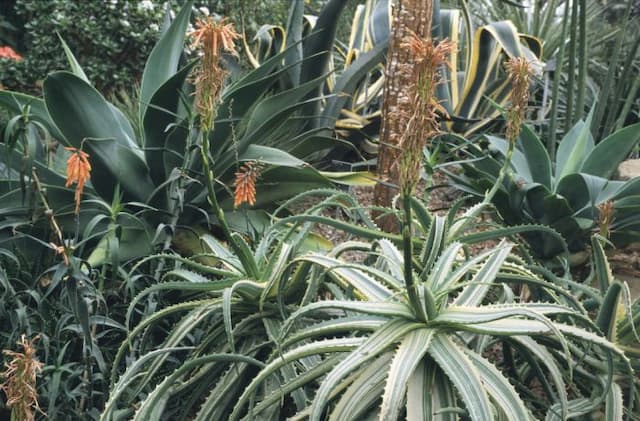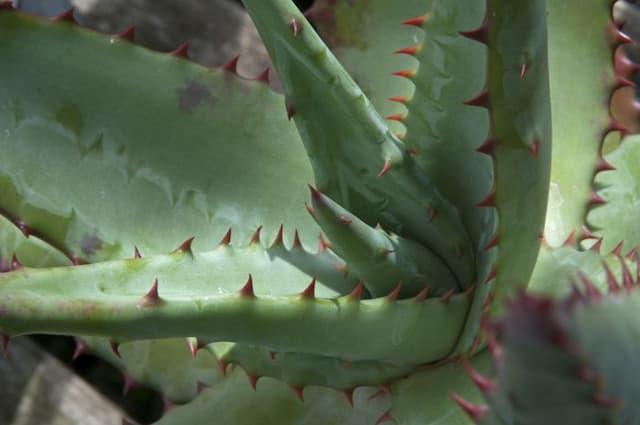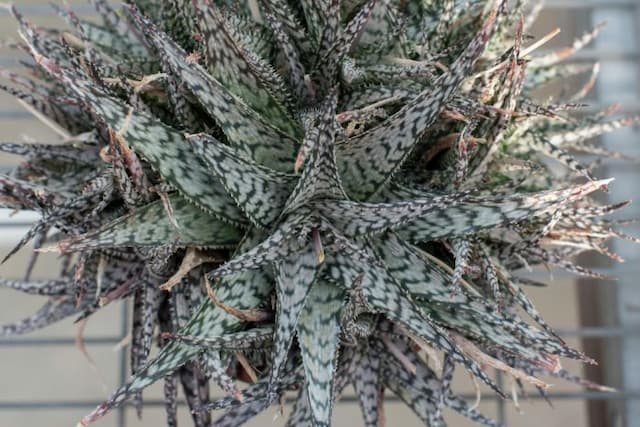Red Hot Poker Kniphofia 'Minister Verschuur'

ABOUT
The Red Hot Poker 'Minister Verschuur' is a distinctive perennial known for its vibrant flower spikes. The blooms are fiery with a gradient of color that typically starts with a creamy white or pale yellow at the base, transitions into a warm orange in the middle, and culminates in a rich, burning red at the tips, evocative of a glowing torch. These tall, upright spires of densely packed flowers create a dramatic visual impact in the garden. The foliage of this Red Hot Poker consists of long, slender, arching leaves that are a deep green, providing a lush backdrop for the dramatic blooms. The leaves gather at the base of the plant in a grass-like clump, from which the flower spikes arise. The overall shape of the plant is quite striking with the contrast between the vertical flower spires and the horizontal foliage. During its blooming season, 'Minister Verschuur' can become a hub of activity as it attracts hummingbirds, butterflies, and other pollinators to its nectar-rich flowers. The impressive, torch-like flowers, combined with the sword-shaped foliage, make this particular Red Hot Poker a popular choice for adding bold color and texture to a garden setting.
About this plant
 Names
NamesFamily
Asphodelaceae
Synonyms
Red Hot Poker, Torch Lily, Tritoma
Common names
Kniphofia 'Minister Verschuur'.
 Toxicity
ToxicityTo humans
Red hot poker is not known to be toxic to humans. There is no widespread report of poisoning or serious consequences resulting from ingesting this plant. However, it is always prudent to avoid eating ornamental plants due to the potential for individual allergic reactions or gastrointestinal discomfort.
To pets
Red hot poker is generally not considered toxic to pets. There are no major reports of toxicity to dogs, cats, or other domestic animals from ingestion. As with humans, it is advisable to prevent pets from eating ornamental plants as they may cause mild stomach upset or an allergic reaction in some animals.
 Characteristics
CharacteristicsLife cycle
Perennials
Foliage type
Evergreen
Color of leaves
Green
Flower color
Orange
Height
3 feet 3 inches [1 m]
Spread
2 feet [60 cm]
Plant type
Herb
Hardiness zones
5
Native area
Africa
Benefits
 General Benefits
General Benefits- Attractive Flowers: The plant produces striking flower spikes in shades of red, orange, and yellow, which can be a focal point in garden designs.
- Drought Tolerance: Once established, it has good resistance to periods of drought, thus lowering water dependency.
- Pollinator-Friendly: It attracts bees, butterflies, and other beneficial pollinators which are crucial for the ecosystem.
- Easy Maintenance: It is generally low maintenance, requiring minimal care once it has settled into its location.
- Deer Resistance: The plant is not preferred by deer, which makes it suitable for areas where deer browsing can be a problem.
- Seasonal Interest: It provides seasonal interest with its foliage and blooms, contributing to the year-round attractiveness of a garden.
- Suitable for Containers: It can be grown in containers, which offers flexibility for people with limited gardening space.
- Border Planting: Its size and form make it suitable for use in borders, adding structure and height.
- Perennial: As a perennial, it returns year after year, making it a long-term addition to any garden.
 Medical Properties
Medical PropertiesThis plant is not used for medical purposes.
 Air-purifying Qualities
Air-purifying QualitiesThis plant is not specifically known for air purifying qualities.
 Other Uses
Other Uses- Knitting and Crochet Dye: The Red Hot Poker can be used as a natural dye for yarns, imparting an orange to yellow color depending on the mordant used.
- Photography Subject: Due to its vibrant colors and unique shape, the Red Hot Poker is popular among photographers looking to add an exotic touch to their floral photography.
- Symbolic Gift: Red Hot Poker plants can symbolize strength and resoluteness, making it a meaningful gift for someone embarking on a new venture or facing a challenge.
- Garden Art: Dried seed heads of the Red Hot Poker can be spray-painted and used in decorative garden art installations.
- Teaching Tool: The plant can be used in educational settings to teach about pollination and floral structures to biology students.
- Landscape Design: As an architectural plant, Red Hot Pokers can be used to add height and texture to modern landscape designs.
- Feng Shui: In Feng Shui, the Red Hot Poker can be used to introduce an element of fire to a garden space, bringing energy and enthusiasm.
- Craft Projects: The stiff foliage of the Red Hot Poker can be incorporated into craft projects, such as homemade bookmarks or greeting cards.
- Eco-printing: The flowers and leaves can be used in eco-printing to transfer their shapes and colors onto paper or fabric, creating natural patterns.
- Winter Interest: Even after the flowering season, the persistent structure of the Red Hot Poker adds visual interest to a winter garden landscape.
Interesting Facts
 Feng Shui
Feng ShuiThe Red Hot Poker is not used in Feng Shui practice.
 Zodiac Sign Compitability
Zodiac Sign CompitabilityThe Red Hot Poker is not used in astrology practice.
 Plant Symbolism
Plant Symbolism- Attention-grabbing: The Red Hot Poker plant, with its vibrant and fiery flower spikes, symbolizes the ability to attract attention and suggests a show-stopping event or personality.
- Strength: Its sturdy form and resilience in growing conditions typically represent strength and the ability to withstand challenges.
- Vibrancy: The bright and intense colors of the plant are often seen as a symbol of vibrancy and life force.
- Standing out: Due to its unique appearance, the Red Hot Poker can symbolize distinctiveness and the quality of standing out in a crowd.
 Water
WaterThe Red Hot Poker should be watered deeply once a week, allowing the soil to dry out between waterings. During particularly hot or dry spells, you may need to water twice a week to maintain moisture levels. Water at the soil level to avoid wetting the foliage, which can encourage disease. New plants require more consistent moisture, so for the first growing season, water enough to keep the soil evenly moist, about 1 inch of water per week. Reduce watering once the plant is established, as Red Hot Pokers are relatively drought-tolerant.
 Light
LightRed Hot Pokers thrive in full sun and require a minimum of 6 hours of direct sunlight daily to perform their best. A spot that gets morning sun and afternoon shade can also be suitable, especially in hotter climates to prevent scorching. However, the brightest light will encourage the most prolific blooming, so aim for a location with unobstructed sunlight.
 Temperature
TemperatureRed Hot Pokers are hardy and can tolerate a wide range of temperatures but grow best when the temperature is between 50°F and 85°F. They can survive temperatures as low as 10°F once established but prefer it not to drop below 50°F for optimal growth. Protecting the plant from extreme cold by mulching can help to ensure its survival in colder zones.
 Pruning
PruningPruning Red Hot Pokers involves removing the flower stalks once they fade to encourage more blooms and maintain a tidy appearance. Cut the stalk at the base after the blooming period, typically in late summer or fall. It's also important to remove any dead or damaged foliage to promote good air circulation and reduce the risk of disease.
 Cleaning
CleaningAs needed
 Soil
SoilThe Red Hot Poker ('Minister Verschuur') thrives in well-drained, compost-rich soil with a pH between 6.0 and 7.0. A mix of two parts garden soil, one part peat or compost, and one part sand or perlite promotes healthy growth.
 Repotting
RepottingRed Hot Pokers ('Minister Verschuur') are typically long-lived perennials and do not need frequent repotting. Repotting can be done every 3 to 5 years or when the plant outgrows its pot or shows signs of stress.
 Humidity & Misting
Humidity & MistingRed Hot Poker ('Minister Verschuur') prefers a moderate level of humidity but is quite adaptable and can tolerate the drier conditions typically found in most home environments.
 Suitable locations
Suitable locationsIndoor
Ensure full sun exposure and well-draining pot mix.
Outdoor
Plant in full sun, amend soil with compost, ensure good drainage.
Hardiness zone
5-9 USDA
 Life cycle
Life cycleRed-hot poker 'Minister Verschuur' begins its life cycle as a seed, which when sown, will germinate in favorable conditions of warmth and moisture. Once the seedling emerges, it grows into a juvenile plant, forming a rosette of narrow, grass-like leaves. As the plant matures, it develops a strong, upright stem that bears dense, spike-like clusters of tubular flowers, ranging in color from yellow to orange-red. After flowering, which typically occurs in late spring to early summer, the plant sets seed, which can be dispersed to produce new plants. Throughout its life, red-hot poker 'Minister Verschuur' is a perennial, returning each year from its fleshy rhizome, which grows in size and stores energy for the next flowering cycle. In the final stage of its life, the plant may eventually decline in vigor, at which point it can be divided and replanted to rejuvenate and maintain the garden display.
 Propogation
PropogationPropogation time
Spring to Summer
The most popular method of propagating the Kniphofia 'Minister Verschuur', commonly known as Red hot poker or Torch lily, is by division. This activity is best done in spring or early summer when the plant is actively growing. To propagate by division, carefully dig up the whole clump of the mature plant. Using a sharp knife or spade, divide the clump into smaller sections, ensuring that each section has at least one growth point or fan of leaves. Replant the divisions promptly at the same depth they were originally growing, spacing them about 18 inches (approximately 45 centimeters) apart to allow enough room for growth. Water the new divisions well to help establish them. This method is effective because it helps to rejuvenate older clumps that might be losing their vigor, and it's a good way to increase the number of plants in your garden without buying new ones.









